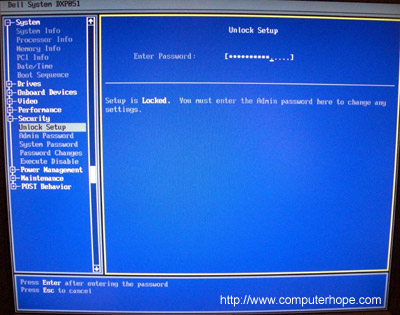* Remove BIOS Password *
If you encounter a password prompt at boot or the BIOS or CMOS setup is locked as shown below and you do not know the password you will need to clear the BIOS password using the suggestions listed below.

Clear using jumper (recommended)
Caution: When inside the computer be sure you're aware of the potential damage that can be caused by ESD.
 On the computer motherboard locate the BIOS clear or password jumper or dip switch and change its position. This jumper is often labeled CLEAR, CLEAR CMOS, JCMOS1, CLR, CLRPWD, PASSWD, PASSWORD, PSWD or PWD as shown in the picture to the right. To change the jumper remove it from the two pins its currently on so that it covers the pin that is not covered. For example, in the picture to the right pins 1 and 2 are covered, you'd remove the jumper and put it on pins 2 and 3. Some computers may also clear the password by keeping the jumper open (only one or no pins covered.)
On the computer motherboard locate the BIOS clear or password jumper or dip switch and change its position. This jumper is often labeled CLEAR, CLEAR CMOS, JCMOS1, CLR, CLRPWD, PASSWD, PASSWORD, PSWD or PWD as shown in the picture to the right. To change the jumper remove it from the two pins its currently on so that it covers the pin that is not covered. For example, in the picture to the right pins 1 and 2 are covered, you'd remove the jumper and put it on pins 2 and 3. Some computers may also clear the password by keeping the jumper open (only one or no pins covered.)
Once this jumper has been changed, turn on the computer and the password should be cleared. Once cleared, turn the computer off and return the jumper or dip switch to its original position.
The location of the jumpers or dip switches are dependent on the manufacturer of the computer and motherboard. However, below are some general ideas on where to find it. Remember that most motherboards could have dozens of different jumpers, make sure you're changing the CMOS jumper and not something else. If these general suggestions do not help refer to your motherboard or computer documentation or skip to the next step.
- On the edge of the motherboard - Most jumpers are located on the side of the motherboard for easy accessibility, verify by looking at all visible edges of the motherboard.
- By the CMOS battery - Some manufactures will place the jumper to clear the CMOS or BIOS password by the actual CMOSbattery.
- By the processor - Some manufactures will place the jumpers by the processor of the computer.
- Under the keyboard or bottom of laptop - If you are working on a laptop computer the location of the dip switch (almost never a jumper) can be under the keyboard or on the bottom of the laptop in a compartment such as the memory compartment.
- Other visible location - While it is possible that the jumpers or dip switches may not be in a visible location, most manufactures try to make things easier by placing the jumpers or dip switches in another visible location.
Generic passwords
Try using Backdoor Password. Note: many of these generic passwords are no longer used or only used with older computers.
Use a BIOS password utility
This is a live cd tool live linux distros just burn it in a cd and then you can use it. To Burn it you can use a linux live cd and boot up and then download the live cd from here and burn it. Most linux distros like Ubuntu, Kali already had utilities for burning cd.
Remove CMOS battery
Removing the CMOS battery like the one shown in the picture to the right will cause the system to lose all CMOS settings including the password. To do this locate and remove the CMOS battery on the motherboard for at least five-minutes. After this has been done put the battery back into the computer and turn it back on.
Jump the CMOS solder beads
Older computers and especially older laptops don't have jumpers or dip switches and require the user to jump a pair of solder beads on a circuit board. The identification and location of these solder beads can vary and if not available in computer documentation is only obtainable through the computer manufacturer.
If you've identified the solder beads they can be jumped by placing a flat-head screwdriver over the two beads and leaving it on those beads while turning on the computer. Once the computer has booted turn off the computer and then remove the screwdriver.

No comments:
Post a Comment